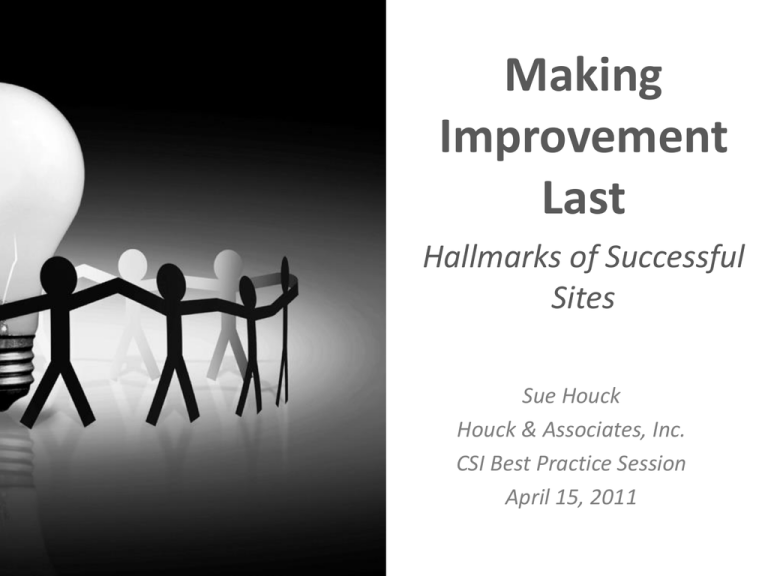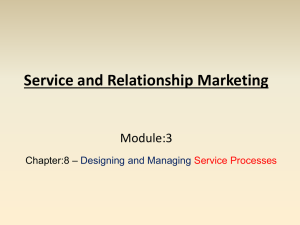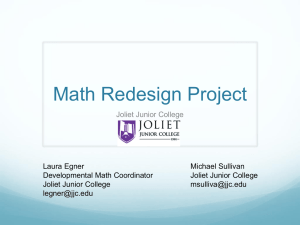Leadership
advertisement

Making Improvement Last Hallmarks of Successful Sites Sue Houck Houck & Associates, Inc. CSI Best Practice Session April 15, 2011 Sources •California HealthCare Foundation’s Ambulatory Care Redesign Collaborative •AAFP’s NDP project •Houck & Associates’ case studies and observed experience Adaptive Reserve “The more successful practices had an internal capability for organizational learning and development. We labeled this capability the ‘adaptive reserve.’” Transforming Physician Practices To Patient Centered Medical Homes: Lessons From the National Demonstration Project. Nutting, P. et al. Health Affairs. March 2011. Adaptive Reserve 1. Leadership 2. Aligned vision 3. Healthy relationships Adaptive Reserve Leadership facilitative vs. authoritarian Aligned vision for clinical care, operations, and financial function Healthy relationships rich communication, shared trust and regular, protected time to reflect and learn Transforming Physician Practices To Patient Centered Medical Homes: Lessons From the National Demonstration Project. Nutting, P. et al. Health Affairs. March 2011. Aligned Vision “There will be many competing demands on time and money. Management must always keep referring back to the priorities set and systems agreed upon and keep everyone on task until the new way becomes completely ingrained and integrated into everyone’s thinking and day to day operations.” Doug Eby, VP Medical Services, Alaska Native Medical Center Leadership “Leadership is central...When leadership hands off improvement, it doesn’t work. It’s also important that physicians buy into a philosophy of improvement.” Dr. Charlie Burger, Nurembega Medical Specialists, Bangor Maine Leadership “Sites that achieved the most impressive gains are led by change agents that are proactively engaging in activities to institutionalize key design features and permanently alter individual and collective work behaviors.” Evaluation of California HealthCare Foundation’s Ambulatory Care Redesign Collaborative. Lewin Group Final Report. Leadership “…change agents that are proactively engaging in activities to institutionalize key design features and permanently alter individual and collective work behaviors.” These include: •Incorporating redesign into structures and activities such as weekly staff meetings to keep staff engaged in redesign •Rotating staff members that are not part of redesign to work with those have have been involved Evaluation of California HealthCare Foundation’s Ambulatory Care Redesign Collaborative. Lewin Group Final Report. Pitfalls of Incremental Vs. Transformative Change “Putting discrete model components in place appears to be far easier than modifying existing roles and work patterns for using them effectively. For example, many practices implemented disease registries without reconfiguring work processes to use them effectively for population management, such as identifying all patients with asthma and proactively suggesting that they obtain influenza vaccination.” Transforming Physician Practices To Patient Centered Medical Homes: Lessons From the National Demonstration Project. Nutting, P. et al. Health Affairs. March 2011. Healthy Relationships “All of our informants spoke to the advantages of creating care teams in order to increase the efficiency of the patient visit. Care teams create a sense of shared accountability for redesign and demonstrate that improved productivity stems from the efforts of a team, not a single provider or staff member.” Evaluation of California HealthCare Foundation’s Ambulatory Care Redesign Collaborative. Lewin Group Final Report. Healthy Relationships Sharing of best practices of other clinics that have adopted redesign was strongly recommended by virtually all sites. This information sharing would allow the groups to collectively solve problems such as resource issues and identify additional improvements. Evaluation of California HealthCare Foundation’s Ambulatory Care Redesign Collaborative. Lewin Group Final Report. Reality Check How would you rate your practice’s adaptive reserve? Quality 1-5 Description Leadership Facilitative vs. authoritarian Vision For clinical care, operations, and financial function Healthy Relationships Rich communication, shared trust and regular protected time to reflect and learn 1=feature is missing or a low priority, 5=feature is present and a high priority in the practice Possibility What 1-3 actions would you take in the next week to improve adaptive reserve at your practice if you know you could not fail? Remember “The good-to-great companies understood a simple truth: Tremendous power exists in the fact of continued improvement and the delivery of results. Point to tangible accomplishments-however incremental at first-and show how these steps fit into the context of an overall concept that will work. When you do this in such a way that people wee and feel the buildup of momentum, they will line up with enthusiasm.” Good-to-Great. Jim Collins.






